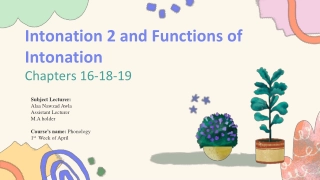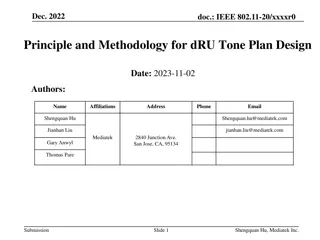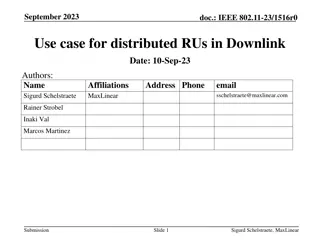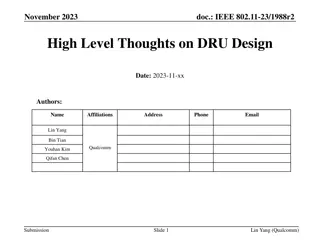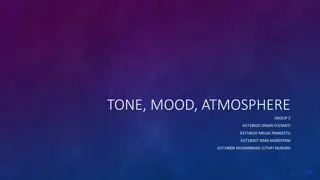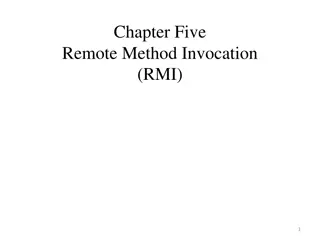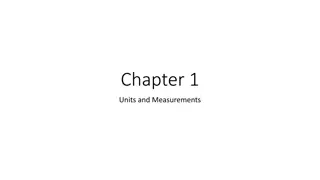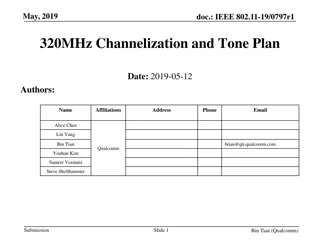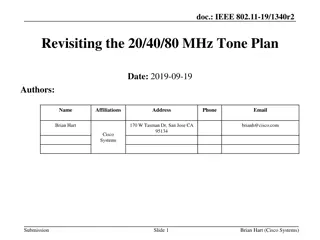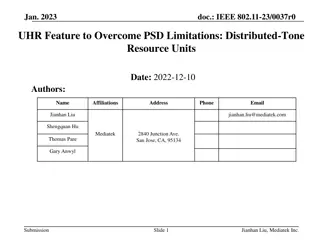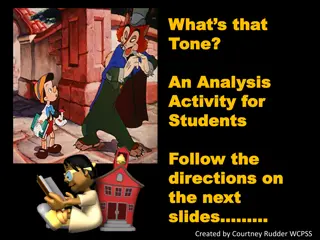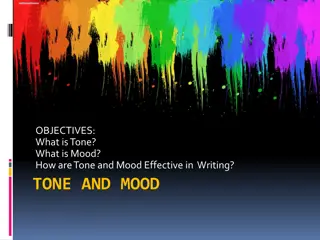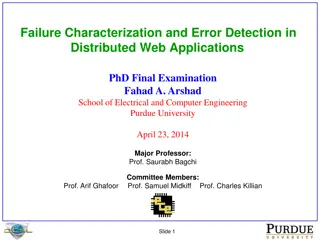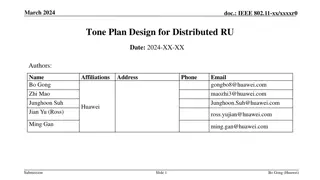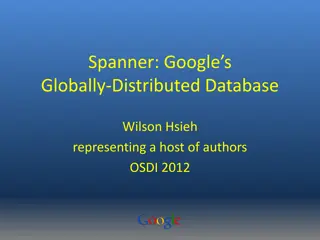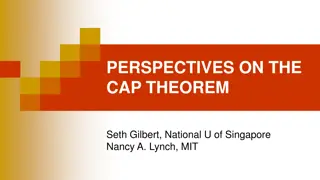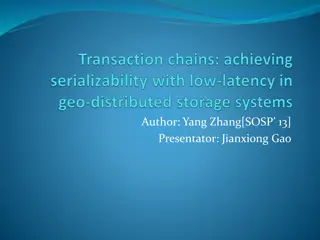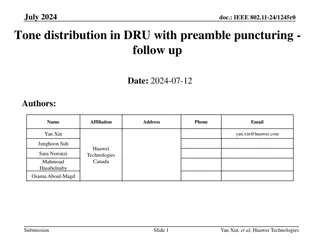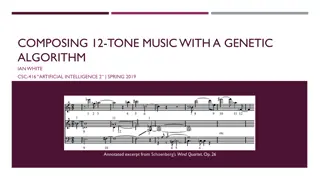Understanding Intonation and Tone in Phonetics
Intonation and tone play crucial roles in conveying meaning and expression in spoken language. Intonation refers to the melodic pattern of speech that can indicate various emotions or grammatical functions, while tone represents the pitch, quality, and strength of vocal sounds within words. By maste
4 views • 27 slides
Efficient Resource Mobilization and Management Strategies by Dr. Abraham Maliet Mamer
This content discusses efficient resource mobilization and management strategies, emphasizing the importance of understanding the typical cycle of resource regime, defining resources, identifying resources, and mobilizing resources effectively. It provides insights into resource allocation methodolo
1 views • 12 slides
Principle and Methodology for dRU Tone Plan Design in IEEE 802.11-20
Introduction of Distributed Tone RU (dRU) as a potential UHR PHY feature to address PSD limitations for 6GHz LPI and enhance Rate vs. Range performance. Emphasis on dRU tone plan design criteria, methodologies, and performance simulations. Detailed examination of design principles, methods, consider
4 views • 23 slides
Overview of Distributed Systems: Characteristics, Classification, Computation, Communication, and Fault Models
Characterizing Distributed Systems: Multiple autonomous computers with CPUs, memory, storage, and I/O paths, interconnected geographically, shared state, global invariants. Classifying Distributed Systems: Based on synchrony, communication medium, fault models like crash and Byzantine failures. Comp
9 views • 126 slides
Understanding Parallel and Distributed Computing Systems
In parallel computing, processing elements collaborate to solve problems, while distributed systems appear as a single coherent system to users, made up of independent computers. Contemporary computing systems like mobile devices, IoT devices, and high-end gaming computers incorporate parallel and d
1 views • 11 slides
Use Case for Distributed Resource Units in Downlink Scenarios
The document explores the concept of distributed Resource Units (dRU) in downlink scenarios in IEEE 802.11 standards like 802.11ax and 802.11be. It discusses the benefits and potential advantages of using dRU in downlink transmissions, focusing on how it can effectively distribute tones across the s
3 views • 13 slides
High-Level Thoughts on Distributed Tone Resource Unit (dRU) Design in IEEE 802.11-23/1988r2 November 2023
Various aspects of Distributed Tone Resource Unit (dRU) design in IEEE 802.11-23/1988r2, such as PSD limitations, distributed transmission regulations, application areas, and open questions are discussed in this presentation by Lin Yang from Qualcomm. Topics include tone distribution, power pooling
0 views • 19 slides
Understanding Tone, Mood, and Atmosphere in Literature
Atmosphere, mood, and tone are essential elements in literature that shape the emotional tone of a literary work, influence reader expectations, and convey the author's attitude. They are interconnected yet distinct aspects that add depth and complexity to storytelling. This analysis delves into the
0 views • 12 slides
Understanding Remote Method Invocation (RMI) in Distributed Systems
A distributed system involves software components on different computers communicating through message passing to achieve common goals. Organized with middleware like RMI, it allows for interactions across heterogeneous networks. RMI facilitates building distributed Java systems by enabling method i
1 views • 47 slides
Distributed DBMS Reliability Concepts and Measures
Distributed DBMS reliability is crucial for ensuring continuous user request processing despite system failures. This chapter delves into fundamental definitions, fault classifications, and types of faults like hard and soft failures in distributed systems. Understanding reliability concepts helps i
0 views • 58 slides
Understanding Units and Measurements in Physics
Physics is the study of nature and its phenomena, involving various physical quantities like mass, length, time, area, and volume. These quantities can be fundamental or derived, with units selected as standards for measurement. The System International (SI) units offer advantages like coherence, ra
0 views • 14 slides
Channelization and Tone Plan Discussion for 320MHz EHT
IEEE 802.11-19/0797r1 discusses the channelization and tone plan design for 320MHz in EHT (11be). The slides cover the benefits of a 320MHz channel, double peak throughput, various BW modes, existing and new configurations, and proposals for tone plans to maximize efficiency. Detailed considerations
0 views • 10 slides
Revisiting the IEEE 802.11-19/1340r2 Tone Plan Optimization
Revisiting the tone plan optimization for IEEE 802.11-19/1340r2, addressing issues with RUs near band edges, accommodating various STA bandwidth capabilities, and the inefficiencies of non-SST 11ax STAs in different BSS scenarios. Proposals include adapting to unknown future 11ax features, minimizin
5 views • 12 slides
Enhancing Wireless Spectrum Efficiency with Distributed-Tone Resource Units in IEEE 802.11
In the document "Jan 2023.doc: IEEE 802.11-23/0037r0," the focus is on leveraging Distributed-Tone Resource Units (dRU) to overcome Power Spectral Density (PSD) limitations in wireless communication. By distributing tones over a wide bandwidth, dRU allows for higher transmit power, enabling enhanced
0 views • 9 slides
Understanding Tone and Mood in Text Analysis Activities
This activity guide created by Courtney Rudder of WCPSS provides students with text excerpts to analyze for tone and mood. Students work in pairs to discuss the text and use a list of tone and mood words provided to help them. The guide progressively offers more challenging texts for analysis, encou
1 views • 9 slides
Economic Models of Consensus on Distributed Ledgers in Blockchain Technology
This study delves into Byzantine Fault Tolerance (BFT) protocols in the realm of distributed ledgers, exploring the complexities of achieving consensus in trusted adversarial environments. The research examines the classic problem in computer science where distributed nodes communicate to reach agre
0 views • 34 slides
Distributed Algorithms for Leader Election in Anonymous Systems
Distributed algorithms play a crucial role in leader election within anonymous systems where nodes lack unique identifiers. The content discusses the challenges and impossibility results of deterministic leader election in such systems. It explains synchronous and asynchronous distributed algorithms
2 views • 11 slides
Understanding Tone and Mood in Writing
Explore the concepts of tone and mood in writing, how they are defined, and their impact on creating an atmosphere and eliciting emotions in the reader. Discover how tone reflects the author's attitude and the multiple tones that can exist in a piece of writing. Dive into the general atmosphere crea
0 views • 34 slides
Understanding the Hemiplegic Arm and Hand After Stroke
A stroke can cause weakness in the arm and hand, affecting movement and daily tasks. Careful handling reduces pain and complications. Common issues include pain, swelling, altered sensation, and muscle tone changes. Limbs may have low tone (limp) or high tone (stiff), leading to challenges in moveme
0 views • 11 slides
Understanding Tone in Literature: An Analysis of Hamlet
Explore the concept of tone in literature through examples from Shakespeare's "Hamlet." Learn how tone influences the reader's emotional response and enhances understanding of a piece of writing. The analysis delves into Act One, Scene One to reveal the tension and tone Shakespeare sets up in the pl
0 views • 10 slides
Introduction to Masonry Units in Construction
Masonry units, such as stone, blocks, or bricks, combined with mortar, are essential in construction, with examples seen in the pyramids of Egypt and the Great Wall of China. Structured and non-structured masonry types serve different purposes, with concrete masonry units being widely used. Solid co
1 views • 33 slides
Overview of Distributed Systems, RAID, Lustre, MogileFS, and HDFS
Distributed systems encompass a range of technologies aimed at improving storage efficiency and reliability. This includes RAID (Redundant Array of Inexpensive Disks) strategies such as RAID levels, Lustre Linux Cluster for high-performance clusters, MogileFS for fast content delivery, and HDFS (Had
0 views • 23 slides
Understanding Verbal Irony and Tone Through Examples
Verbal irony is the expression of words conveying the opposite of their literal meaning. It is not the same as lying and is used to emphasize a point. Tone plays a crucial role in conveying irony, as it can affect how the message is perceived. Sarcasm, though related, has a negative agenda of mockin
0 views • 7 slides
Proposed Stock Complex Amendments for Caribbean Reef Fishery Management Units
Amendments proposed for the reef fishery management units in Puerto Rico and the U.S. Virgin Islands include changes to stock complexes for parrotfish, grouper, and snapper units. The proposal suggests separating parrotfish units, modifying grouper units, and adjusting snapper units. Additionally, t
4 views • 72 slides
Distributed Software Engineering Overview
Distributed software engineering plays a crucial role in modern enterprise computing systems where large computer-based systems are distributed over multiple computers for improved performance, fault tolerance, and scalability. This involves resource sharing, openness, concurrency, and fault toleran
0 views • 66 slides
Unveiling Writing Strategies: Theme vs. Topic Focus and Emphasis on Tone by Emily Mowery
Dive into the nuances of topic vs. theme in literature with a focus on analyzing tone. Explore writing activities, examples from "Poisonwood Bible," tone word banks, and engaging tone activities to enhance students' comprehension and creative expression.
0 views • 11 slides
Challenges in Detecting and Characterizing Failures in Distributed Web Applications
The final examination presented by Fahad A. Arshad at Purdue University in 2014 delves into the complexities of failure characterization and error detection in distributed web applications. The presentation highlights the reasons behind failures, such as limited testing and high developer turnover r
0 views • 53 slides
IEEE 802.11-24/0078r1 dRU Design Approach for 20 MHz
Introduction to the design approach for Distributed Resource Units (dRUs) in the IEEE 802.11-24/0078r1 document for achieving the TGbn PAR goal of Rate-vs-Range. The focus is on designing resource units with low power spectral density to enhance transmit power per tone efficiently. Various tone plan
0 views • 16 slides
Tone Plan Design for Distributed RU in IEEE 802.11 Standards
This document discusses the design of tone plans for Distributed Remote Units (DRUs) in IEEE 802.11 standards. Three main tone plans are proposed: Group based tone plan, Pilot tone power boosted tone plan, and Unified DRU Tone Plan. The group based tone plan focuses on separating pilots, reducing ch
0 views • 26 slides
Google Spanner: A Distributed Multiversion Database Overview
Represented at OSDI 2012 by Wilson Hsieh, Google Spanner is a globally distributed database system that offers general-purpose transactions and SQL query support. It features lock-free distributed read transactions, ensuring external consistency of distributed transactions. Spanner enables property
0 views • 27 slides
Understanding Tone and Mood in Literature
Tone refers to the author's attitude towards the subject, while mood is the emotional atmosphere of the text. The difference lies in how the author feels versus how the reader feels. Understanding and analyzing tone involves considering aspects like diction, imagery, figurative language, and syntax.
0 views • 14 slides
Understanding the CAP Theorem in Distributed Systems
The CAP Theorem, as discussed by Seth Gilbert and Nancy A. Lynch, highlights the tradeoffs between Consistency, Availability, and Partition Tolerance in distributed systems. It explains how a distributed service cannot provide all three aspects simultaneously, leading to practical compromises and re
0 views • 28 slides
Understanding Distributed Hash Table (DHT) in Distributed Systems
In this lecture, Mohammad Hammoud discusses the concept of Distributed Hash Tables (DHT) in distributed systems, focusing on key aspects such as classes of naming, Chord DHT, node entities, key resolution algorithms, and the key resolution process in Chord. The session covers various components of D
0 views • 35 slides
Distributed Database Management and Transactions Overview
Explore the world of distributed database management and transactions with a focus on topics such as geo-distributed nature, replication, isolation among transactions, transaction recovery, and low-latency maintenance. Understand concepts like serializability, hops, and sequence number vectors in ma
0 views • 17 slides
Character Analysis of Mrs. Schulewitch and Adam Seth from Over the Bridge
Explore the character analysis of Mrs. Schulewitch and Adam Seth from the novel "Over the Bridge" by Todd Strasser. Uncover their communication style, history, appearance, relationships, ambitions, character defects, thoughts, everyman-ness, and restrictions. Dive deep into the tone of the song and
0 views • 4 slides
Tone Distribution in DRU with Preamble Puncturing
The document discusses tone distribution in Distributed RU (DRU) with preamble puncturing in IEEE 802.11 networks. It explores the impact of preamble puncturing on subcarrier distribution and proposes solutions to optimize tone plans in DRU designs. Various rearrangements and tone distribution strat
1 views • 23 slides
Distributed Computing Systems Project: Distributed Shell Implementation
Explore the concept of a Distributed Shell in the realm of distributed computing systems, where commands can be executed on remote machines with results returned to users. The project involves building a client-server setup for a Distributed Shell, incorporating functionalities like authentication,
0 views • 14 slides
Understanding Tone in Writing: Strategies and Examples
Explore effective strategies for identifying the tone of a passage, including non-committal, anticipatory, and accusatory tones. Learn how to navigate uncertainty by first determining the basic tone, such as positive, negative, or neutral. Gain insights into authorial attitudes and opinions, and pra
0 views • 13 slides
Composing 12-Tone Music with Genetic Algorithm - An Exploration
This annotated excerpt delves into the world of 12-tone music composition using a genetic algorithm approach. The essence of 12-tone music, its historical roots, and the simplifications made for the algorithm's purposes are discussed. The piece structure, transformations, and an initial task involvi
0 views • 15 slides
Analysis of Trump's First 100 Days News Coverage
Explore the news coverage of Trump's first 100 days in office, focusing on who dominates the narrative, the key topics covered, tone of coverage, and how it varied by news outlets and over time. Data from Media Tenor spanning Jan 20 to Apr 29, 2017, reveals insights on talking time allocation, cover
0 views • 11 slides
